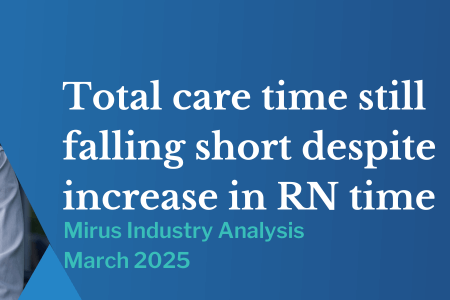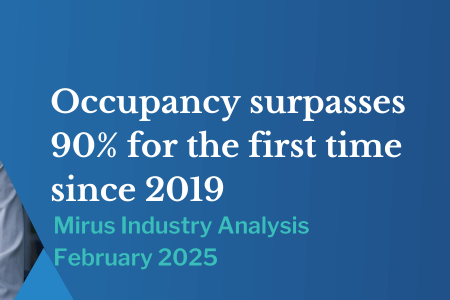Four AN-ACC case studies and the lessons learned
December 4, 2023 | Aged Care Management

By Andrew Farmer, CEO and Partner
After more than a year of AN-ACC, we have worked with over 100 providers to adjust their funding processes to the new AN-ACC model. Most of the industry are still evolving their internal structures and models. In this blog, we will review four real-life examples of approaches and the lessons learned.
Case study 1: The provider has been using a system for AN-ACC and focusing on the right data but not enough.
Most providers are still learning and understanding the nuances of running an AN-ACC process. This provider has a competent funding manager, who understands the model and the processes required to optimise the funding while also balancing care minutes. They are also using a specific AN-ACC system to support this process. Across multiple facilities however, this process is working better at some facilities than at others. So, what could be going wrong? The answer seems to be capacity. While they understand the process and what needs to happen, there is not enough hours in the day to get through the work required to keep the data clean and the process optimised across all facilities.
An important point to note is that AN-ACC is a lower risk process compared to ACFI due to external assessment and no validation risk. There is more separation between the funding processes and the delivery of quality care in the sense that the two processes are achieved through different mechanisms and with different compliance requirements. The funding processes require external assessment through an algorithm designed to assess a funding level and care minute requirement with a lower level of detailed knowledge of the resident. The funding and care minute outcome is an average for all residents in a facility, rather than a specific requirement for each resident. Quality care on the other hand is governed by care planning and the quality standards and requires a detailed clinical knowledge that is specific to each resident.
Getting the balance right is difficult but the less specific requirements for AN-ACC is what makes it suitable to more remote activities. Many providers have begun to centralise these activities and even to outsourcing some parts of the process to have internal teams focus on higher order activities. Otherwise there will continue to be upward pressure on resourcing and capacity for the AN-ACC process and if this is being performed by clinical resources, this activity is not counted towards care minutes.
Case study 2: The provider has been building a system but has got to the point where the data is not reliable and the build and maintenance of the system is resource intensive.
After the shadow assessments were first published and the process to download the data from My Aged Care manually commenced, many providers began developing spreadsheets to analyse the assessment data. This practice has persisted and is still widely in place today.
With the requirements of the Quarterly Financial Reporting (QFR) for care minutes, providers also began developing better and better reporting from payroll and other systems to analyse care minutes. A few providers have also invested heavily in building more sophisticated applications for AN-ACC.
This case study is an example of the latter and the provider is finding that the complexity, cost and time associated with building systems is far greater than anticipated. The level of functionality required to analyse inputs of roster data and funding data but also overlay clinical data and perform scenarios is a level of complexity too great for spreadsheets and BI platforms. To try to do this is not only complex but requires substantial investment. Even those that do this well will find that it is a significant undertaking.
One important consideration often overlooked is the aspect of data security and data accuracy. Cyber security and data accuracy is a big issue and those in technology and procurement disciplines would know that ISO27001 is a minimum requirement these days.
This is not so easily achieved.
Another important factor is that internally built systems are only advanced by the insights and requirements of one business. Vendor systems are built from feedback from many providers insights and this “wisdom of the crowd” helps the system to improve more quickly in multiple ways for the benefit of all users. The cost of building the system to be secure, high quality and high functionality is then shared across many providers.
Case Study 3: The provider is only one site and has a manual process that is manageable until things go wrong
This provider was satisfied that the AN-ACC process was under control because the funding outcome seemed ok and there were few problems with the process. One interesting aspect of developing processes and systems for AN-ACC is that it affects different size organisations in different ways. While larger organisations may have more resources and more sophisticated systems, the problems faced are at a greater level of scale and materiality. Smaller scale processes (single site) can often hide problems because they can be fixed locally, are relatively small and relatively few.
Many manual parts of the process can exist at any size provider. While manual processes can be adjusted easily, they often rely on one key person, the data is not secure or can’t be analysed and there is no audit trail and therefore there is less accountability for errors across the process.
The advantage of a small provider is that the scale and number of issues are smaller but with a relatively risk-free process and scarcity of clinicians, this is a perfect opportunity for single site providers to outsource this process. With the correct tools and remote access to Care Management System data, this process can be remotely managed, and the required decision support information fed simply into internal management processes.
Case study 4: The provider has transitioned all their ACFI staff on site to AN-ACC and has a multi million dollar salary cost
A recent survey conducted by Mirus Australia with over 150 providers indicated 43% had transitioned all of their ACFI resources to AN-ACC resources. This provider was an example of that and was still allocating clinical resources at each site as well as regional and central resources.
There are many different models being employed for AN-ACC and they are evolving. These range from significant decentralised, to more centralised and even outsourced. Some organisations have also started to merge clinical documentation and quality roles with the funding roles to take advantage of the need to have strong documentation in place to support the external assessment process.
Our survey suggested 25% of providers have reduced ACFI resources and a further 33% have centralised or outsourced the process. Technology (including AN-ACC data and transaction management) is almost essential to create efficiencies and allow central/outsourced solutions.
This case study provider like many others we work with has a team that is managing AN-ACC quite well but is finding that these valuable resources (often RNs) are spending most of their time on lower-level tasks, just capturing and reviewing the data. Often these resources are applying onerous review and checking processes in place that hark back to the ACFI days and protecting the organisations from validation risk and sudden funding claw backs. In some cases, the level of clinical diligence might be overkill since the external assessor will reach their own conclusions from the information available at the time of the assessment.
A provider’s primary goal in funding must be to ensure that the majority of subsidy entitled to is being received. This requires significant diligence and data collection. We have proposed a more efficient process is to outsource the base level data gathering with some efficiency gained from technology and then utilise their own resources to trouble shoot, focus on quality information and work with management on meeting strategic objectives across quality, funding, occupancy and rosters.
Conclusion
The new AN-ACC world is here and after more than a year, some trends are beginning to emerge on good practise in AN-ACC processes. Technology and accurate data management appears to be critical, as is looking at the most efficient model to achieve the funding outcome with consideration for the reduced risk in the model due to the external assessment process. The risk now is in not actively managing AN-ACC carefully enough analytically and allowing “revenue leakage” where the maximum subsidy achievable is reduced by not making timely adjustments against care minute targets.
If you are interested in a further discussion on how your specific model is working, please reach out to us.


